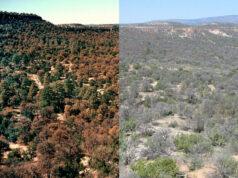Life on LEO: Plants to be Added to the Landscape Evolution Observatory at Biosphere 2
Surprisingly little is known about how rain moves through landscapes once it’s on the ground. UArizona’s Landscape Evolution Observatory is designed to provide answers. A $3.5 million grant will allow scientists to study the roles plants and microbes play in the process.
Daniel Stolte
Tuesday
University Communications
LEO-Feature.jpg
One of three artificial hillslopes in the Landscape Evolution Observatory. Each is equipped with 1,900 sensors and sampling devices that enable scientists to monitor water, carbon and energy cycling processes and the physical and chemical evolution of the landscape at small and large scales.
Aaron Bugaj
Science and Technology
Biosphere 2 College of Agriculture and Life Sciences College of Science Grand Challenges Research Science Strategic Plan Water
Media contact(s)
Researcher contact(s)
Scott Saleska
Professor, Ecology and Evolutionary Biology
Find your dream job in the space industry. Check our Space Job Board »
The National Science Foundation has awarded $3.5 million to a team led by University of Arizona researchers to study how life prevails in barren landscapes, such as those disturbed by wildfires, volcanic eruptions or mining operations.
The research will yield new insights into the effects of a changing climate on such landscapes, and could someday even help astronauts raise crops on Mars.
LEO-B2-Aerial.jpg
The Landscape Evolution Observatory is housed under the steel-and-glass architecture of UArizona’s Biosphere 2.
Aaron Bugaj
Researchers from UArizona, Lawrence Berkeley National Laboratory and California Lutheran University will establish a complete ecosystem – with plants, artificial rain and sophisticated monitoring technology – on the large artificial hillslopes at the Landscape Evolution Observatory, or LEO, located inside UArizona’s Biosphere 2. The experiment will offer scientists a detailed look at how emergent plant life interacts with soil, water and carbon dioxide from the atmosphere to create more complex ecosystems.
“In a nutshell, we’re getting ready to put life on LEO in the form of plants,” said Scott Saleska, a professor in the Department of Ecology and Evolutionary Biology who took over as LEO’s director of science earlier this year. “This grant will allow us to answer a question central to ecology: Can we predict what is going to happen when we build up an ecosystem from scratch? LEO allows us to literally watch life’s complexity build up from ground zero.”
LEO is the world’s largest laboratory experiment in the interdisciplinary earth sciences. The experiment consists of three artificial landscapes that mimic watersheds in the natural world, each contained within elaborate steel structures housed in three adjacent bays under the glass-and-steel domes of Biosphere 2. Each hillslope is 100 feet long and 35 feet wide and blanketed with 1 million pounds of crushed basalt rock, layered 3 feet deep. Each of LEO’s hillslopes is studded with 1,900 sensors that allow scientists to observe each step in the landscapes’ evolution – from lifeless soil to living, breathing landscapes that will ultimately support complex microbial and vascular plant communities.
LEO-moss.jpg
The first organisms to colonize a barren landscape are microbes and less complex plants, such as these mosses growing on rock created by a volcanic eruption.
Aaron Bugaj
Over the past five years, researchers have used LEO to gain in-depth knowledge of how landscapes evolve in the absence of plant life other than microbes and mosses. Those studies focused on the interactions between soil and water, with the water being provided through a sophisticated irrigation system that simulates various kinds of rain. The new NSF grant kicks off a new phase of the project, allowing researchers to study more complex interactions between the physical and biological components of LEO’s ecosystem, particularly between tiny microbial communities and higher plants.
Water, Water Everywhere – But What Does it Do and Where Does it Go?
The world faces the increasingly urgent question of how to better understand and manage complex physical-biological systems to address pressing problems such as how to restore degraded landscapes, practice sustainable ecosystem management and terraform planets beyond Earth. Terraforming is the science of transforming hostile environments into land that can grow crops.
By adding plants with roots and vascular systems to LEO, Saleska’s team will study how plant life affects a well-established physical system and test hypotheses about the interactions between plants and microbes.
Project co-leader Katrina Dlugosch, associate professor of ecology and evolutionary biology, selected alfalfa as the model plant organism to be planted at LEO because it has been thoroughly studied, and its genome has been sequenced and is well-known. Alfalfa also commonly enters in symbioses – or partnerships – with microbes capable of scrubbing nitrogen from the atmosphere and converting it into nutrients the plants can use.
LEO-underside.jpg
LEO’s three giant hill slopes rest on load cells — electronic circuits that measure changes in the weight of the slope’s contents depending on how much water is added, runs off or leaves through evaporation or transpiration.
Aaron Bugaj
“Alfalfa provides one of the key features of primary succession – the process of life colonizing an environment that has very little to offer in terms of nutrients,” Dlugosch explained.
“We think there will be a strong selection in this harsh environment on how these plants establish and maintain their partnerships with the microbes, and we are looking to understand both the ecology of that and, down the road, the biological evolution of this hillslope community as a whole,” said Malak Tfaily, assistant professor in the UArizona Department of Environmental Science.
The team also will use LEO’s hillslopes as models for watershed environments in the natural world. Experiments will test how water flows through landscapes, how that affects the weathering of rock to soil, and the effects of those processes on landscapes and their biological habitability.
“The basic question boils down to: What happens to the rain?” said Peter Troch, UArizona professor of hydrology and atmospheric science and a member of the project’s steering committee. “We are going to test how water is used by plants through root water uptake or contributes to aquifer recharge and streamflow.”
Troch expects the results to inform land management practices such as water conservation measures in water-limited environments and plant selection in landscape restoration efforts.
A key part of the project is its scalability, Saleska added. What researchers learn from studying small patches of plants growing on the LEO hillslope can be applied to full landscapes.
The project, titled “Growing a new science of landscape terraformation: The convergence of rock, fluids, and life to form complex ecosystems across scales,” was selected by NSF under its Growing Convergence Research program, which aims to solve complex research problems with a focus on societal needs. In addition to experts in hydrology, geochemistry, evolutionary genomics and ecology, the LEO team will include anthropologists who study cultures of science, with the goal of breaking new ground in how researchers from historically separate disciplines can better share and integrate their ideas and insights for the benefit of the world.
“These are extremely competitive grants, specifically created to address some of the world’s greatest challenges, and to even be considered requires a portfolio of interdisciplinary scholarship and technological capability that the university excels at bringing together,” said University of Arizona President Robert C. Robbins. “The fact that our researchers continue to attract these types of grants speaks to the unique ecosystem of talent, technology and perseverance that our faculty bring to the table.”
Other members of the LEO project steering committee include Jon Chorover, head of the Department of Environmental Science; Jennifer Croissant, associate professor in the Department of Gender and Women’s Studies; Elizabeth “Betsy” Arnold, a professor in the School of Plant Sciences and the Department of Ecology and Evolutionary Biology; and William Riley, senior scientist at Lawrence Berkeley National Lab in Berkeley.











